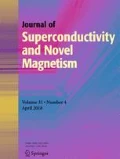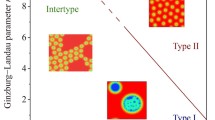Abstract
Interband superconductivity channels with pairs formed from the same (a) and different bands (b) are compared in common action. A simple mean-field multiband model is inspected. There are three order parameters Δ a , Δ a d and \({\Delta }_{b} \left ({\Delta }_{b1}^{2}={\Delta }_{b2}^{2} \right )\). Complicated quasiparticle energies induced by interactions of strengths W a and W b follow. The calculated operator averages lead to a coupled nonlinear system for the gap-type parameters. Illustrative calculations of them vs temperature have been made. Overlapping dispersive bands intersected by the chemical potential have been used. A novel result is that at a fixed parameter set the system of basic equations has two independent solutions. The free energy is of a complicated structure under the action of both channels. There are stable and metastable states. The W a and W b channels compete in simultaneous functioning. The phenomenon of the effective logout of one of the channels can be traced. Starting by the temperature where Δ i reached zero, the solutions induced by W j behaving as W i were zero and define T c i . The pairs Δ a and Δ a d have the same vanishing temperature. The general results are very sensible to |W b | inclusive to critial behaviour. Reduced |W b | stimulates the formation of closed “bubbles” built up by Δ a , Δ b and Δ a d belonging to parallel solutions. The corresponding metastable state vanishes when the bubble closes.
Similar content being viewed by others
1 Introduction
In the classical (BCS) one-band superconductivity only the intraband pairs of the type (a k ↑ a −k ↓ ) appear. In multiband superconductivity (e.g. [1–7]) additional interband pairing channels are opened. The corresponding pairs can be of the intraband and interband (a k ↑ b −k ↓ ) nature. These pairing channels are attributed to pair transfer and pair scattering processes correspondingly. In the four fermion HF language the efficiency of them is determined by the exchange and Coulombtype integrals. The chemical potential (μ) position in the band complex is decisive for the both cases. A multiband background allows μ to “choose” between the bands. However the most successful case for the interband superconductivity corresponds to crossing points of the overlapping bands bearing together μ. In the case of a pair transfer process with intraband pairs there are no remarkable restrictions on the momentum space volume which can be used. This channel is in general expected to prevent and is supposed in the literature preferably for “convenient” systems. It is simple to see that the pair scattering interband interaction is not able to use the full \(\vec {k}\)-space. It can be effective only by momentum space regions with coincidence of the Fermi surfaces of the interacting bands. That is, there are restrictions. The formation of interband pairs is usually (necessarily) expected for triplet pairings in various spin systems, etc. It seems that the features following from the simultaneous action of interband interactions generating the pairs of the same and different band composition are not well known. Especially this concerns quantitative applications to real superconducting systems.
2 The Model and Basic Equations
We investigate a three-band system with unconnected a- and b-bands coupled by pair-transfer (W a ) and scattering interactions (W b ) with the itinerant band d. This system is described in the mean-field approximation by the Hamiltonian H 0 + H i . The unperturbed part reads here
and the superconductivityinducing interaction term is
Here the order parameters Δ a and Δ a b are connected to the channel (W a ) and Δ1b with Δ2b to the (W b ) one. The band energies \( \epsilon \left (\vec {k} \right )=\xi \left (\vec {k} \right )-\mu \) are counted from the chemical potential; σ is the spin index.
The a-channel W a generates intraband pairs (; marks equivalency)
and W b – the interband pairs
These quantities must be self-consistently calculated. Our Hamiltonian can be simply diagonalized e.g. by the two-time Green’s function method. The renormalized band energies and the necessary operator averages contained in (3)–(4) lead to a coupled nonlinear system for a-, ad- and b-gaptype parameters. These are determined by the following nonlinear coupled equations (Θ = k B T)
Here the quasiparticle energies of the renormalized bands appear in the form \(E_{a}=\pm \sqrt {{\epsilon _{a}^{2}}+{{\Delta }_{a}^{2}}} \) and \(E_{1}=\pm \frac {1}{2}\sqrt {R+2\sqrt P } \) ; \(E_{2}=\pm \frac {1}{2}\sqrt {R-2\sqrt P } \) for the a- and b-connected channels determining the quasiparticle spectral peaks. Here R and P are distinct combinations of the band energies and the order parameters.
The system (7–9) determines the nonzero extremal points of the free energy as a function of nonequilibrium order parameters and refers the formation of pairing correlations between the particles.
Taking all Δ-s to be zero in (7–9) one arrives to equations which determine the critical (Curie-Weiss) temperatures for the transitions into ordered (superconducting) states. At this Δ a and Δ a d couple have a common zero; also \({\Delta }_{b1}^{2}={\Delta }_{b2}^{2}\). In general
3 Quantitative Illustrations
We have taken the band dispersions for two-dimensional illustrative calculations as
The constants A and B have been taken to guarantee functionality of both pairing channels on the chosen background. Inspecting various spectral configurations of the order parameter complexes with various W a and W b we have found that the a-channel can become active for essentially lower interaction strengths. To overwhelm this the W b has to be taken as greater and the superconducting effects appear in an unrealistic region (a-channel had the possibility to take the job earlier). This can also be the result of our band dispersions used. However the simultaneous inclusion of intra- and interband pairing channels for the same system deserves a special discussion.
An unexpected result of the numerical calculations consists in the presence of two solutions for the Δ(T)-s complex for the same parameter set. This is illustrated in Fig. 1 (also in Figs. 2 and 3). It means that there are own complexes of anomalies in the free energy driven by W a and W b in simultaneous work. The minima, metastable minima and associated barriers can appear. The presence of such two gaptype extrema sets is organized by the details of dispersive band overlaps. In the case of nondispersive bands with constant densities of states the second (2) solution in Fig. 1 is missing. There are then no \(\vec {k}\)-s such as \(\epsilon _{b}(\vec {k})=\epsilon _{d}(\vec {k})\).
We have found a lot of manifestations that the channels with different pair compositions compete in simultaneous functioning. The momentum region effective for one of the channels restricts it for the other. For example, the higher is Δ b initiated by W b , the stronger is depressed the (Δ a , Δ a d ) complex and vice versa. The larger component of them is affected more.
The competition of these two pairing channels creates also a novel event of effective channel logout, as illustrated also in Fig. 1. When a Δ i ruled by W i reaches zero, the ohter Δ j initiated by W j behaves as the W i channel were closed (W i =0). The temperature dependence of Δ j follows now the curve known for the case of W j working alone. Note the critical points seen in Δ b (1) and Δ a (2) when correspondingly Δ a (1) and Δ b (2) vanish (Fig. 1). So, until Δ a (1) and Δ a d (1) follow their ordinary lowering with enhanced T the Δ b (1) rises but starts to diminish after the critical point is reached.
For a single | W b | channel it is known [8] that the behaviour of the dependence of Δ b (T) varies markedly with weakening coupling. The standard superconducting dependence of Δ b becomes substituted by closed “bubbles”. It means the formation of a metastable superconducting state by an unsufficient magnitude of the coupling. Analogous behaviour is seen to be reflected also in our present model. Depending on the interaction strengths there can be solutions only of the bubble form, as in Fig. 2. The superconductivity is absent in this case until the bubbles do not disappear. The rising coupling |W b | induces the bubbles to become longer (these end on higher temperatures) and stimulates them to vanish.
All the bubble configurations in Fig. 2 vanish on a common temperature. The bubbles itself are formed from the same type parameters from the two parallel solutions. Basing on the gaps order at T = 0, the upper branch of the bubble is attributed to a maximum (barrier) and the lower one to an associated minimum. Rising temperature washes out this extremum.
Rising coupling strength |W b | causes the rupture of the Fig. 2 configuration as is shown in Fig. 3. Transition from Fig. 2 to Fig. 3 illustrates also that a small enhancement of |W b | passing a critical threshold (controlled by smaller |W b | differences compared to Figs. 2 and 3) leads to a total reconstruction of the gaps’ organizations. By the bubbles’ rupture the connection of two parallel solutions present in Fig. 2 is lost. The “free” branch of the Δ b (2) in Fig. 3 with the highest vanishing temperature can now be considered as the superconductivity T c
We conclude that in simultaneous functioning of superconducting channels intra- and interband pairs compete. Complicated distribution of the free energy extrema arises.
References
Hong, X.Q., Hirsch, J.E.: Hole superconductivity in a generalized two-band model. Phys. Rev. B 45, 12556–12560 (1992)
Kruchinin, S., Nagao, H., Aono, S.: Modern aspects of superconductivity. World Sci. 230 (2010)
Kondo, J.: Theory of multiband superconductivity. J. Phys. Soc. Jpn. 71, 1353–1359 (2002)
Zehetmayer, A.: A review of two-band superconductivity, pp. 1–40. arXiv:1402.3956 (2014)
Innocenti, D., Boccia, N., Ricci, A., Valletta, A., Caprara, S., Perali, A., Bianconi, A.: Resonant and crossover phenomena in multiband superconductors. Phys. Rev. B 82(184528), 1–12 (2010)
Schmidt, A.A., Rodriquez-Nunes, J.J., Bianconi, A., Perali, A.: Two-bands superconductivity with intra- and interband pairing, pp. 1–8. arXiv:1012.3417 (2010)
Tanaka, Y: Multicomponent superconductivity based on multiband superconductors, Supercond. Sci. Techn 28, 1–18 (2015)
Kristoffel, N., Veende, K: Interband superconductivity in spin-polarized bands. Physica C 471, 188–192 (2011)
Author information
Authors and Affiliations
Corresponding author
Ethics declarations
Funding
This work was partially supported by the European Union through the European Regional Development Fund.
Rights and permissions
About this article
Cite this article
Kristoffel, N., Rubin, P. Simultaneous Action of Intra- and Interband Pair Channels in Multiband Superconductivity. J Supercond Nov Magn 29, 611–614 (2016). https://doi.org/10.1007/s10948-015-3321-1
Received:
Accepted:
Published:
Issue Date:
DOI: https://doi.org/10.1007/s10948-015-3321-1







